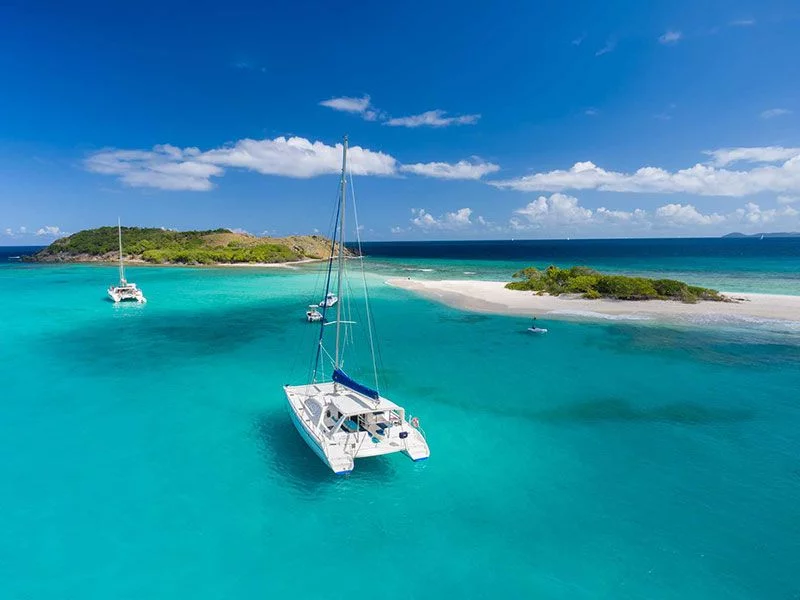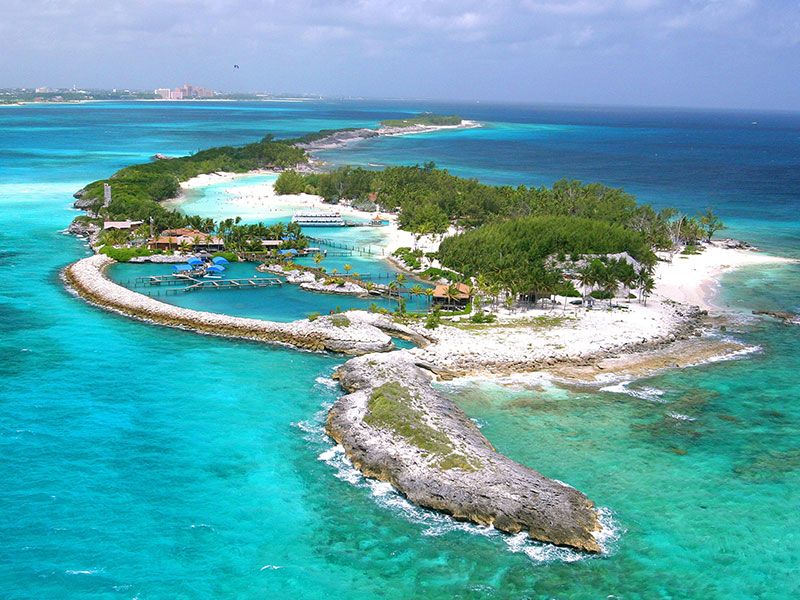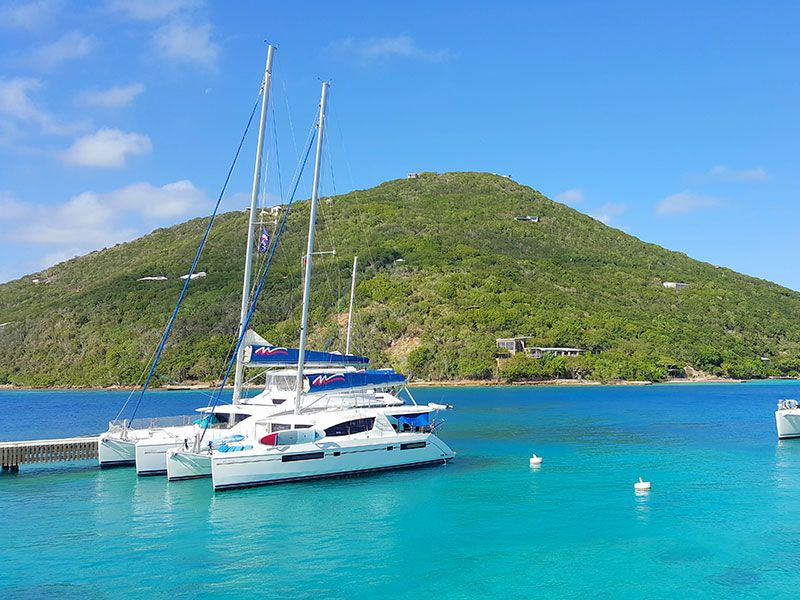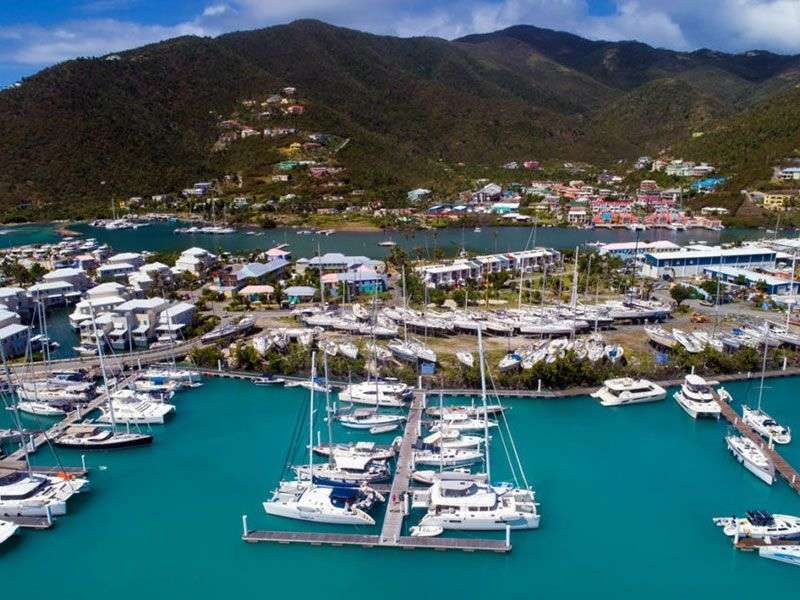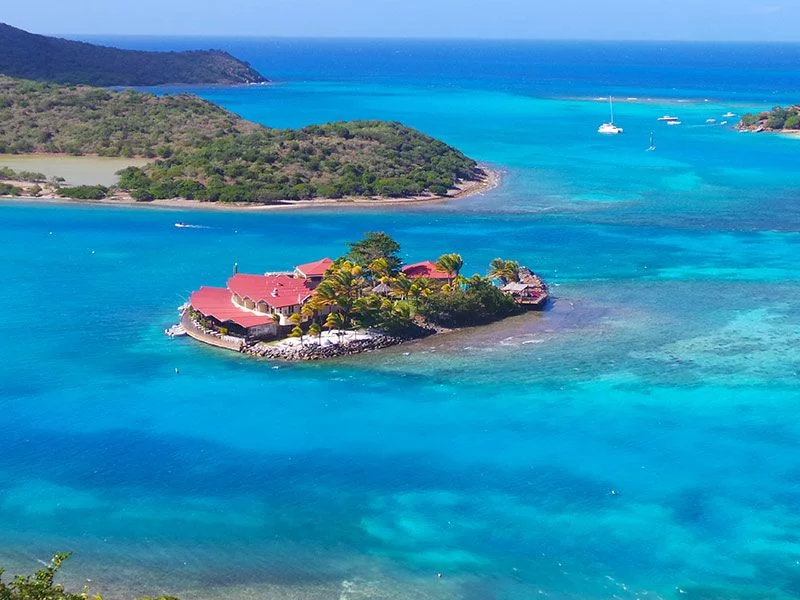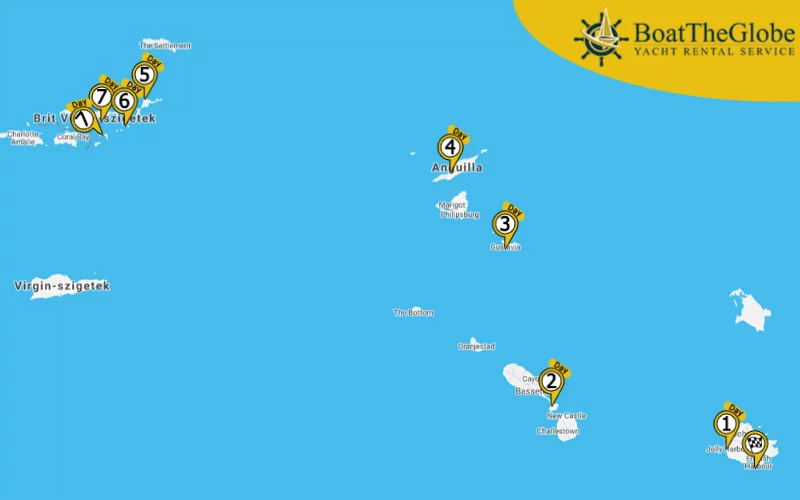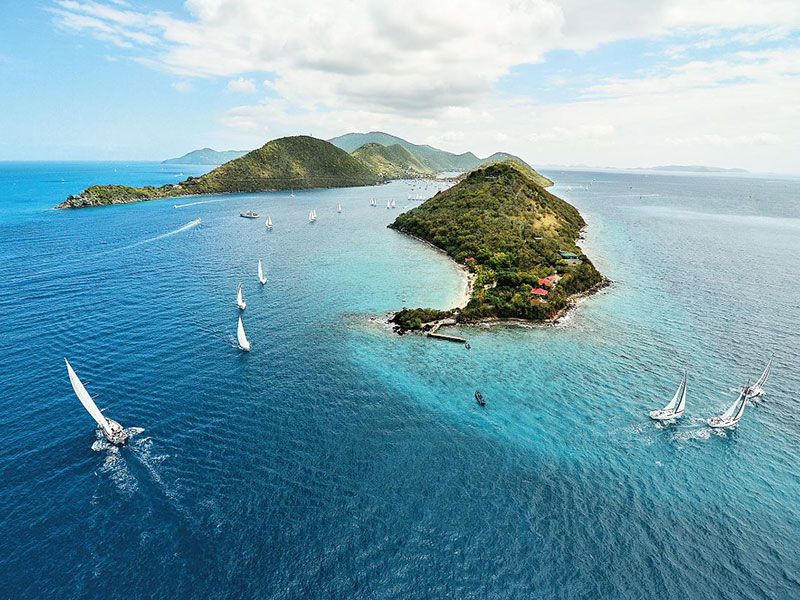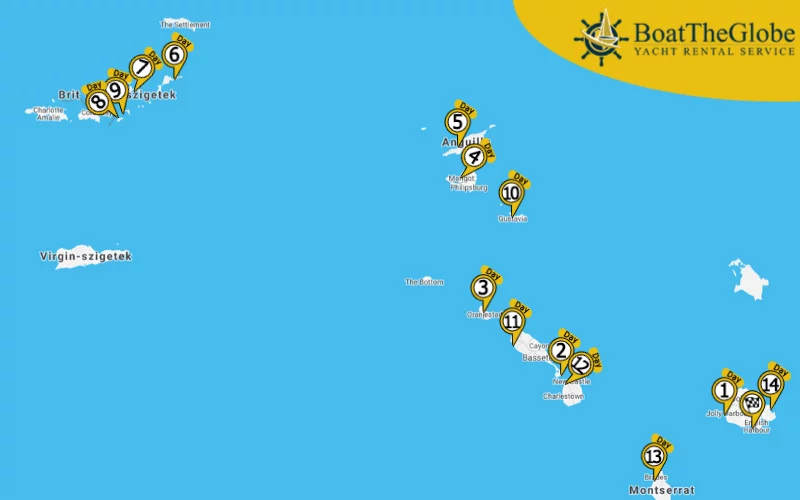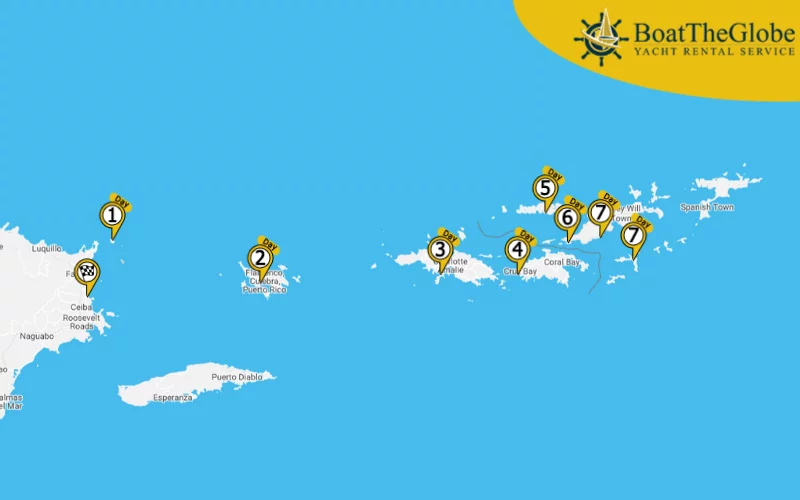Planning a sailing trip to the British Virgin Islands? The British Virgin Islands are one of the most diverse sailing destinations in the Caribbean. Coastal and interisland sailing within the British Virgin Islands is one of the safest Caribbean destinations for beginners. In contrast, routes to and from the British Virgin Islands are serious, open-water crossings, and are only for experienced skippers. This guide will help you navigate which British Virgin Islands sailing routes are right for you, when they are safe, and when you should opt for shorter, more sheltered sections.
This article gives you an overview of the following topics:
- The most important things we need to know when sailing to the British Virgin Island
- The largest islands of the British Virgin Islands
- Sailing to the British Virgin Islands – itineraries
- On way BVI catamaran cruise from Antigua
- Catamaran trips to BVI: 2 weeks yachting from Antigua to BVI
- BVI catamaran cruises: 7 days sailing from Puerto Rico to BVI one-way
The most important things we need to know when sailing to the British Virgin Islands
The Virgin Islands are a group of islands located in the northwestern part of Leeward Islands. They are divided into two parts: the American and the British Virgin Islands. The British Virgin Islands belong to the overseas territories of the United Kingdom. It consists of over 50 islands, only 16 of which are inhabited. The largest islands are Tortola, Virgin Gorda, Anegada, and Jost van Dyke; all of them are volcanic except Anegada. Smaller islands include Peter Island, Beef Island, Salt Island, Cooper Island, and Norman Island. The capital of the archipelago – Road Town –can be found on Tortola. The area is the most popular sailing spot in the region, ideal for beginners in coastal sailing, but the area also offers serious offshore challenges for experienced sailors.
Climate – the best time to sail to the BVI
The British Virgin Islands have a tropical climate; it is hot during the entire year, but the dominant trade winds somewhat cool the air down. The period between December and March is usually milder, with an average temperature of 24–25° Celsius. It is very hot between May and October: the daily average temperature is around 28° Celsius. The dry period lasts from January to April; the driest months are February and March. There are heavier rainfalls from May to December, particularly on Tortola and Virgin Gorda where the larger hills and mountains are. sailing in BVI in December
The hurricane season is from July to October – it brings strong winds and heavy rains. The sea is warm during the whole year, with an average temperature of 27° Celsius. The most popular period for sailing is between December and April. During this time, the weather is not so hot and the amount of precipitation is also smaller; there is also a lower risk of tropical storms and hurricanes. It is important to note that while sailing within the British Virgin Islands can be planned year-round, longer ocean crossings (from Antigua, Puerto Rico) are only recommended during the high season (December–April).
Winds
The wind is northeasterly during the winter months, then blows towards the east in February and changes its course to the southeast by June. It usually has a velocity of 28–38 km/h, with the exception of the Christmas winds with 50 km/h. The seas are fairly calm. The tidal range is relatively small on the islands: it is between 30 and 40 centimetres. This includes the change in sea levels caused by the atmospheric pressure and the winds.
Clearance
When sailing to the British Virgin Islands, we should stop at one of the entry ports. (Road Harbour or West End, Tortola; Great Harbour, Jost Van Dyke; Spanish Town, Virgin Gorda.) As the area for docking is limited at these places, we are only allowed to anchor in the dock for the time of our clearance. We can only continue our way to the yacht port after that. We will need the vessel’s documents that we received at the previous port; the passenger’s list and their passports.
The buoys placed at the shores of the British Virgin Islands are marked in different colours. Yellow ones are for merchant vessels, and white ones can be used by sailboats up to 18 meters long. After obtaining the required navigating licence, we can use these for free during the day. Red buoys mark the most protected areas; it is only allowed to dock at these parts for up to 90 minutes.
The largest islands of the British Virgin Islands
Each member of the British Virgin Islands is beautiful with a wonderful view and full of natural beauty; in addition, none of them is densely populated. The Sir Francis Drake channel offers calm waters and quiet winds that all skippers dream of. After our daily sailing trip, all we have to do is dock at a beautiful port. Then we can have a swim at one of the spectacular beaches and go to a local bar or restaurant at the end of the day. Rent a boat in BVI and enjoy complete tranquillity as you glide from one beautiful bay to another.
Tortola
Tortola is the largest member of the British Virgin Islands; its capital is Road Town. It has wonderful shores. Most of them can be found on the northern side of the islands such as Smuggler’s Cove, Long Bay, or Garden Bay. Besides sailing, there are several opportunities for surfing, scuba diving, and hiking as well. The town has many sophisticated and well-equipped marketplaces. It’s important to mention that it has become one of the most popular destinations of large cruise ships during recent years; the presence of these mega yachts may cause congestion at some ports.
Road Town belongs to the large bay on the southern side of the island. The port of Fort Burt is located in the northern corner of this bay. There is a fuel dock here. Road Reef Marina can be found to the south, in the continuation of the channel. There are rarely any free docking places here, but we will find some great ones a little bit further, which are less crowded. The lagoon Wickhams Cay provides even more yacht ports including Village Cay, Moorings, and Treasure Island. Tortola will definitely not be a disappointment – it is a true sailing centre where we can have a wonderful time. Read more about what to do in Tortola or Tortola sailing. yacht charter in Tortola
Virgin Gorda
Virgin Gorda is the third-largest member of the British Virgin Islands; its capital is Spanish Town. An island is a great place in all respects. One of the most exciting sights here is the beach of Baths. This is a collection of granite rocks on the beach that have become large rock formations. The rocks from tidal basins, channels, and spectacular caves open to the surrounding waters. We can dock at the western side of Fallen Jerusalem or at Virgin Gorda Yacht Harbour in the southeast. Savanna Bay, located a little further to the north, is also a fascinating place, especially if we are brave enough to navigate behind the reef. In the north, we can find other good docking places in Leverick Bay. Read more about what to do in Virgin Gorda or Virgin Gorda sailing. yacht charter in Virgin Gorda
Jost Van Dyke
Jost van Dyke is a very popular destination among sailors – its most famous port is the Great Harbor, which is also one of the busiest docks of the archipelago. The other significant port, Little Harbor is a beautiful and quiet dock with app. 20 buoys altogether. It can be easily accessed through Garner Bay, but the water is fairly shallow on both sides. On the northern coast, the depth of water varies between 4.5 and 9 metres. On the northeastern coast, at the edge of the bay is Little Harbor Marina where we can refuel our boat and replenish our water and ice supplies.
White Bay is another, less crowded docking place. It can be found west of Great Harbour, on the southwestern side of the island. We can enter the port in three different courses; the middle one is marked the best. The docking area is quite small, but we will still love the place if we want to enjoy the beach.
Peter Island
Peter Island is the fifth-largest member of the British Virgin Islands. The infrastructure is not very developed, but they have designated hiking and cycling routes. We can get to know the spectacular flora and fauna of the island while exploring these. The beautiful beaches face the Caribbean Sea, the Atlantic Ocean and the Sir Francis Drake Channel It is definitely worth visiting the place, as the island offers several great docking spots and yacht ports. Little Harbor is a small but very well protected port, and Great Harbour – located to the east – is also a great place for docking. It is important to note, however, that the water at Great Harbour is too deep to secure our boat.
Peter Island Resort and Yacht Harbor are located on the northern side of the island, on Sprat Bay. This is a more exclusive and sophisticated place. As for the southern coast, we can find great docking spots on White Bay. One of the advantages of the island is that we shouldn’t expect many boats around – it is a less-known place due to the fact that it is located farther from the most popular routes. It is perfect for those looking for privacy.
Anegada
Anegada is the only inhabited island of the British Virgin Islands consisting of coral and limestones. The coral atoll here is the resting place of several sunken ships; there is a wonderful sight under the water. The waters are rich in fish and sea life. Thanks to the beaches, which are scattered around in the area, as well as the small villages and the hospitality of the locals, sailors often return to this island. The docking area behind Pomato Point is also wonderful; however, the depth of water here is barely 2 metres. We can still find other anchorage points at a small village called Settlement, located north of the Setting Point. The area is easily accessible: there is a designated course leading us straight to the place. Being a fishing island, it is less crowded.
Other amazing docking places and tiny islands on the British Virgin Islands
Soper’s Hole – Tortola
Soper’s Hole is located at the western end of Tortola. The port has the typical characteristics of the British Virgin Islands. We can enter quite easily, as the entrance is spacious; the confluence is ideal and the port is also well-protected. However, we should expect some traffic here as well. There are several spots in the area where we can tie up our boat, most of them in the eastern-northeastern parts. There is also a port established for smaller boats at Soper’s Hole Wharf and Marina, on the western side of Frenchman’s Cay. It is a beautiful place with a colourful design. They provide access to fuel and water. There is a great supermarket here as well, where we can buy anything we need from local groceries to drinks and imported products.
Nanny Cay – Tortola
Nanny Cay can be found on the southern side of Tortola – the two are connected by a short bridge. It is located a little over 3 kilometres from Burt Point. At this port, we have the opportunity to pull our boat from the water, among other services. They have dozens of berths, both internal and external. We need to pass through a narrow route for entry. We can find Hannah Bay Marina a little bit further to the south, continuing our way on this route. There are small restaurants, supermarkets, and boutiques in the neighbourhood.
Cane Garden Bay
Cane Garden Bay is an excellent docking place with a beautiful beach on the northern coast of Tortola. It is easy to enter, there is a large area for docking, and we will have a wonderful view of Jost van Dyke. The bay is surrounded by marvellous mountains, and some of the local restaurants entertain their guests with live music. Many sailors consider this the best port.
Guana Island
Guana Island can be found to the north from the northeastern corner of Tortola. We can anchor at White Bay, which is a well-protected docking place with a nice beach. We can also admire a beautiful coral flower in the northern corner of the island.
Beef Island
Beef Island is located east of Tortola – the two islands are connected by the Queen Elizabeth II Bridge. The Terrance B. Lettsome International Airport – which is the main airport of the British Virgin Islands – can also be found here. It is rarely mentioned among sailors as it has only a few berths – we can find these in the reef behind Whale Rock and at Bluff Bay. They are very secure, and tying up the boat is easy as well. There are no established ports, restaurants, bars, or even any restaurants here, but in return, we can relax in a peaceful environment with practically no crowds.
North Sound
The North Sound is among the northernmost areas of the British Virgin Islands; it is practically a “boat playground”. They offer many places for docking and anchoring. We can also visit several tiny islands from here, such as Moskito Island, Eustatia, Saba Rock, Prickley Pear, and Necker Island. There are many activities we can do here from hiking to scuba-diving and partying at night. The only problem we may have is that we can’t try everything if we are on a tight schedule.
Saba Rock
Saba Rock, located in the northeastern part of Virgin Goda on North Sound, has a fascinating history. Bert Kilbride, the founder of Introductory SCUBA Course arrived at Saba Rock during the ’60s and made the territory his own base. After a few years, he opened his bar, Pirates Pub here, then he established some berths as well. With time, this tiny piece of land became a shelter for skippers. Later he sold the place and a holiday resort was built here. They kept the berths though, and the place is still attractive thanks to the sailing-oriented attitude. They also established a museum on the island, which is definitely worth visiting.
Prickley Pear Island
Prickley Pear also belongs to North Sound. We can find many berths here, and the place is perfect if we want to spend some time alone. The southeastern corner of the island is rarely visited; there are only a few docking places here. A little bit further, there is a port for smaller boats, too, giving us the opportunity to go ashore on the beach. There is a part above Vixen Point where we can encounter corals, so we should be careful. Another perfect spot for securing our boat can be found at the Cactus Reef at the northwestern corner of the island. It is not among the most frequently used docking places, despite the fact that it is protected well and there is also an amazing view from here.
Sailing to the British Virgin Islands – itineraries
HELP ME TO CHOOSE The British Virgin Islands offer countless unforgettable travel opportunities. As a very popular cruise destination, most areas of the area are focused on meeting the expectations of those arriving by ship. So, whichever route you choose, you can be sure that your time here will be memorable. With a one-way trip, you can reach many more places and get to know the area better. There are airports on several islands in the region, but charter transfers and international arrivals are typically most practical in and around Tortola. A round trip, however, will be more of a challenge for sailors. Depending on the weather, a given section may prove easy, while the return trip will be more of a test. If you have decided to sail to the British Virgin Islands, the real question will be how much time you will spend here.One-way BVI catamaran cruise from Antigua
On this route we sail to the British Virgin Islands from the south and west. We depart from Antigua and travel along the Leeward Islands to the easternmost part of the archipelago, Virgin Gorda. There is a longer journey between Anguilla and Virgin Gorda, for which we should be well prepared. We will cross the Anegada Passage, which is a notoriously difficult section. After the open sea crossings, there are more sheltered, easier sections in the British Virgin Islands, where the emphasis is on relaxation and inter-island sailing. The final destination is Nanny Cay, Tortola. From there, although with a transfer, we can fly back to Antigua.
Longer daily stages, where the influence of the Mistral is also stronger. Recommended level: Intermediate, advanced. Open sea sections: partially.
Day 1. Antigua, English Harbour – Jolly Harbour
21, 00 km (13, 05 nm)
Jolly Harbour is a smaller town on the southeastern shores of Antigua. There are 150 wide berths altogether in the dock of the yacht port – all of them have access to water and electricity. There are 13 larger berths a bit further from the dock. The port is protected well; the bulge of the ocean cannot be felt. We can get to the small port town from here on a small boat; we can find a restaurant and a supermarket there. They have an established fuel dock, located in one of the best-protected parts of the port. Services include engine and boat maintenance, and we can also replenish our water and ice supply.
Day 2. Jolly Harbour – St. Kitts, White House Bay
89, 10 km (55, 36 nm)
Although it is difficult to find a good docking place on St. Kitts, White House Bay – located on the southeast – is an exception. The bay offers excellent protection in all conditions. The depth of water varies between 3 and 12 metres; it is app. 4 metres near the shores. There are no establishments, but the beach is wonderful – we can even admire spectacular starfish on the sandy sea bottom.
Day 3. White House Bay – Saint Berthelémy, Gustavia
89, 60 km (55, 67 nm)
Gustavia is both the capital and the most significant port of Saint Berthelémy. Port de Gustavia is among the best docks on the island, and it is also a sailing centre offering a full service. They have 100 berths, and the depth of water is 7 metres. The town was built on a horseshoe-shaped peninsula and is surrounded by a protected port and the ruins of an old fort. The place is a unique sight thanks to the bright red houses.
Day 4. Gustavia – Anguilla, Sandy Ground
65, 80 km (40, 88 nm)
Sandy Ground is the most important dock on Anguilla. The environment is peaceful here, the bay is surrounded by beautiful hills from the north and the south. Local boats and charter vessels usually use the central part of the bay. They made huge efforts to preserve the authentic nature of the island; as a result, they expect fewer tourists, but their service is still excellent. Sailors who visit the island can anchor on the sea, and there are some berths as well further in towards the beach.
Day 5. Sandy Ground – Virgin Gorda, The Bitter End
138, 65 km (86, 15 nm)
Bitter End is located at Spanish Town, in the eastern part of Virgin Goda. Here we can find everything we are looking for: amazing berths, boat slips, fuel, water, restaurants and even an open-air cinema. There is also a wonderful view of North Sound from this spot.
Day 6. The Bitter End – Cooper Island, Manchioneel Bay
23, 95 km (14, 88 nm)
Cooper Island is located a few kilometres from the southern coast of Tortola. The designated docking area is at Manchioneel Bay; they offer 30 berths for boats up to 18 metres long. The port has a pleasant atmosphere, and we can find a nice beach nearby as well. There are great opportunities for scuba diving in the area. If we venture to the eastern side of the island, we should be aware that we will face a group of rocks called Dry Rock. The rocks are not marked, so we must pay close attention not to hit them.
Day 7. Cooper Island – Norman Island – Tortola, Nanny Cay
21, 90 km (13, 61 nm)
What makes Norman Island an amazing place is the fact that there are plenty of great docking places here. One of the most popular ones among them is the Bight. It is a very well-protected bay located in an idyllic natural environment. Kelly’s Cove can be found at the eastern entrance of the Bight; if we prefer to stay away from the bustle, we should dock here. There are wonderful scuba-diving spots north of Norman Island, at the tiny Pelican Island. It is a gorgeous place, but we should arrive early to find a good place to dock. The so-called Caves can be found at Treasure Point, at the southwestern corner of the island. It belongs to the national park, so we have to tie our boat to a buoy. It is definitely recommended to visit these caves if we are on the British Virgin Islands.
Although Irma, the most devastating hurricane of recent times has left its mark on Nanny Cay, if you want to have nice drinks and eat delicious food, you should stop here. There are cultic bars waiting for thirsty travellers like the Soggy Dollar Bar. Anyone who is looking for a dance club will also find some awesome places.
Catamaran trips to the BVI: 2 weeks yachting from Antigua to BVI
We begin our 14-day trip in Antigua as well, but we will travel on our boat all the way. We will spend a few days on the British Virgin Islands in the middle of the week and then sail back to Antigua on a slightly different route. The beauty of the route lies in the fact that, besides getting to know the British Virgin Islands better, we can also explore other parts on the Caribbean Sea.
Longer daily stages, where the influence of the Mistral is also stronger. Recommended level: Intermediate, advanced. Open sea sections: partially.
Day 1. Antigua, English Harbour – Jolly Harbour 21, 00 km (13, 05 nm), Day 2. Jolly Harbour – St. Kitts, Christophe Harbour 81, 60 km (50, 71 nm), Day 3. Christophe Harbour – Sint Eustatius, Oranjestad 49, 90 km (31, 01 nm), Day 4. Oranjestad – Saint Martin, Marigot, Marina Port Royal 76, 20 km (47, 35 nm), Day 5. Marigot – Anguilla, Sandy Ground 26, 80 km (16, 65 nm), Day 6. Sandy Ground – Virgin Gorda, Biras Creek 137, 60 km (85, 50 nm), Day 7. Biras Creek – Beef Island, Bluffy Bay 24, 00 km (14, 91 nm), Day 8. Bluffy Bay – Peter Island, Great Harbor 11, 20 km (6, 96 nm), Day 9. Great Harbor – Salt Island 7, 35 km (4, 57 nm), Day 10. Salt Island – Saint Barthelémy, Gustavia 182, 85 km (113, 62 nm), Day 11. Gustavia – St. Kitts Marine Works 64, 00 km (39, 77 nm), Day 12. St. Kitts Marine Works – Nevis, Tamarind Cove Marina 28, 60 km (17, 77 nm), Day 13. Tamarind Cove Marina – Montserrat, Little Bay 57, 10 km (35, 48 nm), Day 14. Little Bay – Antigua Nonsuch Bay – English Harbor 69, 10 km (42, 94 nm)
BVI catamaran cruises: 7 days sailing from Puerto Rico to the BVI one-way
We will begin this route in one of the largest port towns in Puerto Rico, Fajardo. Navigating towards the east almost all the way, we will first stop at the Spanish Virgin Islands, and then will get to the British Virgin Islands through the American Virgin Islands. This is a beautiful route with unique ports at all stops. We can get back to San Juan from Tortola on a direct flight in only 45 minutes.
Shorter sections, but with more open seas and border crossings. Recommended level: Intermediate, advanced. Open sea sections: partially.
Day 1. Puerto Rico, Fajardo, Puerto del Rey Marina – Cayo Icacos 12.40 km (7.70 nm), Day 2. Cayo Icacos – Culebra, Ensanada Honda 39.20 km (24.35 nm), Day 3. Ensanada Honda – Saint Thomas, Crown Bay Marina 37.20 km (23.11 nm), Day 4. Crown Bay Marina – Saint John, Cruz Bay 19.30 km (11.99 nm), Day 5. Cruz Bay – Jost van Dyke, Great Harbor 14.10 km (8.76 nm), Day 6. Great Harbor – Tortola, Frenchman’s Cay 8.65 km (5.37 nm), Day 7. Frenchman’s Cay – Peter Island, Little Harbor – Nanny Cay 16.25 km (10.10 nm)
There are of course many different variations of a sailing trip to the British Virgin Islands. We can leave from a closer island such as St. Croix or Anguilla, or from a more distant one like Guadeloupe or Grenada. There is a southeast route, which is a popular challenge among sailors, starting on the Turks and Caicos Islands; it leads us all the way to the archipelago along the northern shores of Puerto Rico. This route requires at least two weeks to complete, and we have to spend most of our time on the boat. However, the British Virgin Islands are so beautiful that even a short round trip in the area will be a truly inspiring experience all the same. More about BVI sailing
How to choose?
A good route is not the longest, but the one that fits your skills, the season and the desired experience. The British Virgin Islands are exceptionally flexible in this regard – if you choose consciously.
- If this is your first time sailing in the Caribbean: choose a BVI cruise. Short distances, protected waters, minimal stress.
- If you already have sea experience but don’t want extremes: the Puerto Rico → BVI route is a good transition, with a gradual challenge.
- If you are an experienced captain with a stable crew: the Antigua → BVI crossings give you real ocean sailing.
Find Caribbean luxury yacht charter, crewed yacht charter Caribbean, bareboat yacht charter Caribbean, catamaran rental Caribbean, last minute yacht charter Caribbean, sailboat charter Caribbean, motor yacht charter Caribbean, luxury catamaran charter Caribbean, bareboat catamaran charter Caribbean, bareboat motor yacht charter Caribbean, Caribbean sailing yacht charter bareboat, sailing holidays Caribbean skippered, luxury motor yacht charter Caribbean, luxury sailing yacht charter Caribbean, crewed catamaran charter Caribbean, bareboat catamaran charter Caribbean
Request a quote and book a yacht: fill out our form below today and set off on an unforgettable sailing adventure in BVI!
